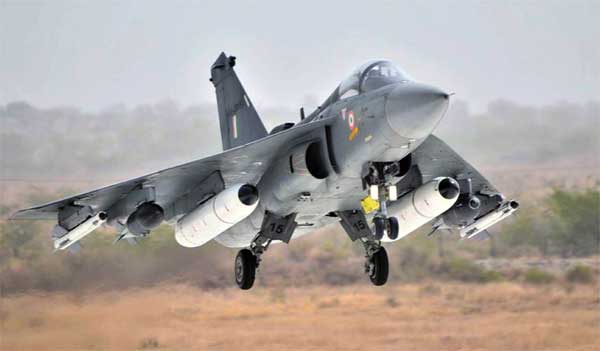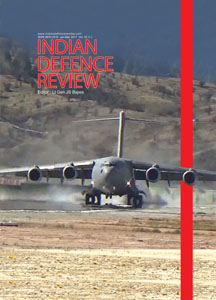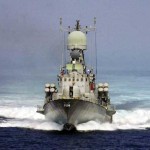Israel, India’s Natural Aerospace Partners
According to an international survey, Israelis like Indians the most and there is a ground swell of pro-Israel opinion in India. India established formal diplomatic relations in 1992 and defence ties with Israel in 1996. The first military contract was IAF’s Air Combat Instrumentation in 1996. This was followed by Dvora patrol boats for the Indian Navy. India has purchased Barak Naval anti-missile defence system, Phalcon advanced airborne early warning radars for India’s IL-76-based AWACs, Heron and Searcher Unmanned Aerial Vehicles (UAVs), Night Vision Goggles, Spider quick-reaction surface-to-air missiles, Green Pine early-warning and fire-control radars and many other items such as Laser guidance kits and Head-Up-Displays. Israel is currently the world’s sixth biggest defence exporter and India, one of the major buyers. Israel is the second largest exporter of UAVs in the world.
Israelis like Indians the most, and there is a ground-swell of pro-Israel opinion in India…
Additionally, ELTA maritime radars are flying on IAF Jaguars and the Multi-Mode Radar is on India’s LCA Tejas. An ELM-2022-based radar is fitted on IAF’s aerostat system. ELTA airborne jammers are on several Indian fighter aircraft. IAI and India’s Defence Research and Development Laboratory (DRDL) are in joint development and production of the long-range Barak missile system. Elbit has a joint venture with HAL to manufacture simulators and avionics for the latter’s Skylark mini UAVs. This will also help HAL in developing its own UAVs. Under a 2008 agreement, Rafael was awarded a contract to supply the IAF with Spyder Low-Level Quick Reaction Missile systems (LLQRM) armed with Python and Derby missiles.
In 2007, a joint venture of $2.5 billion for the co-production of Medium-Range Surface-to-Air Missiles (MRSAM), capable of hitting targets up to 70 kilometres away was signed. In August 2009, India signed a $2.5 billion deal with IAI and Rafael for the joint development of a new, advanced version of the Spyder Surface-to-Air Missile.
Indo-US Aviation Bond
Indo-US relations have come a long way since the cold vibes of the 1950s which had pushed India into the Soviet camp. USAF-IAF contact had begun after the Sino-Indian War of 1962 when the USAF ran Exercise Shiksha in India to teach modern Air Defence techniques. Four decades later, starting 2004, Cope India series of exercises began, followed by IAF participation in the Top-Gun Red Flag Exercise. A serious relationship started with the US offering high-end aircraft and India procuring six Special Operations aircraft C-130J-30s “Super Hercules”. Additional six have since been ordered.
Indo-US relations have come a long way since the cold vibes of 1950s which had pushed India into the Soviet camp…
Ten Boeing C-17 Globemaster III, strategic lift aircraft were acquired next. The 77.5 tonne payload C-17 can operate from short and rough airstrips and will augment India’s ability for inter-theatre movement of troops and equipment. Eight Boeing P-8I Neptune, meant for Anti-Submarine Warfare (ASW) aircraft, ship interdiction roles, and Electronic Intelligence (ELINT) began joining from May 15, 2013. Four more have been ordered. The IAF will also soon have 22 Boeing’s Apache AH-64 Longbow helicopters in its inventory to replace the ageing Russian attack helicopters. This will also bring day-and-night sensor suite, AGM-114 Hellfire missiles and Hydra 70 rocket pods. The Indian Army will later get 39 Apaches. 15 Boeing CH-47 Chinook heavy-lift helicopters for the IAF will also be part of the massive arms diversifying shift for India. With the ability to carry up to 55 troops or 12,700 kg cargo, the Chinook will be used in air assault missions and inserting troops into fire bases. Once cleared at Government level, dealings for most US systems are with private companies and they are easier to deal with.
HAL, PSUs and Private Industry
The HAL has made thousands of fixed and rotary wing aircraft in the last 70 years. Other than the HF-24 Marut, and a few trainers, and more recently, the LCA Tejas, all aircraft have been of foreign origin, licence-produced in India. In most of these cases, India has been dependent on foreign suppliers even for relatively low-end technologies. Often licence production was at the mercy of foreign supplied systems or parts. At times, small parts either become obsolete or no one manufactures them due poor economics of scale. HAL was only partially successful in creating local vendors for these parts.
The Indian aviation industry is dependent on many DRDO labs and other Defence PSUs…
HAL has had production quality issues in spite of full foreign production technology drawings. Major components of the LCA, the engine, radar, ejection seat, avionics and most weapons are imported. A better approach could have been Joint Ventures or best reverse engineering which the erstwhile Soviet Union and more recently, China had mastered. The logistics chain for the IAF often means routing spare parts to foreign vendors through HAL. HAL’s ability to arm-twist foreign vendors is relatively low. Also, many foreign suppliers are worried of India becoming independent of them and keep delaying supplies to HAL intentionally. The Indian aviation industry is also dependent on many DRDO labs and other Defence PSUs who in turn are also dependent on foreign firms. Complexities for them are similar. While it is encouraging to see some major private players entering defence production, industry has still to takeoff in a big way because of small scale and high-risk investment. All eyes are on DPP 2016 to make a difference.
Operational Management
India has mastered the art of operationally managing mixed fleets of aircraft. The IAF has seven types of fighter aircraft today. In the recent past, India has integrated a large number of fully programmable Western and Indian avionics even in Russian aircraft such as SU-30, Mig-27 and MiG-21 Bison. They all connect with Russian onboard systems through a common data-bus and a universal mission computer. Russian aircraft do have some commonality of systems; but spare parts nomenclatures being different did make it difficult for the IAF to manage inventories for many years.
The Pakistan Air Force has decided to restrict its fighter aircraft fleet to just three to four types in the long run. Even though the IAF will have sizeable numbers of Su-30 and LCA, the number of fighter types will always be around five to seven. Beyond 2025, the IAF will mostly have Russian, British, French, Indian and maybe, even American fighter aircraft. Larger aircraft inventories do add to costs but till we build a strong indigenous defence industry, geo-politically, it is best to spread the eggs in different baskets. Interoperability would have to be managed through regular exercises. Signing of Logistics and Maintenance Agreement (LEMOA) with USA will also bring the militaries logistically closer.
The Pakistan Air Force has decided to restrict its fighter aircraft fleet to just three to four types…
Logistics and Maintenance Complexities
Western nations have had the capitalist culture for long. Countries like the US do have strategic or political reasons for military supplies; but most European countries primarily have commercial interests. This has heightened after the end of the Cold War and India’s emergence as an economic power. The Soviets, to politically win over India, earlier supplied aircraft in barter for ships load of bananas, shoes or hosiery. After the break-up of the Soviet Union in 1991, the payments are in hard dollars, but the mindset of many in the aircraft industry has still to recover from the Soviet hangover. Signing of even small contracts for spares takes years to obtain approval.
Some Russian production houses are financially weak because of considerably reduced orders. Russian combat aircraft per unit initial costs have always been lower, but the life cycle costs have invariably been high and also the system serviceability often low. The long repair cycle involving complex export-import procedures, the Russian fleet serviceability has been low at between 50 to 60 per cent. While Western nations have adopted modern online means of spares monitoring and supply, Russians mostly follow the old system of indenting.
The IAF’s contract with France on Mirage 2000 for door-to-door delivery of spares is worth emulating. Serviceability and mission accomplishment rates of some Western fleet have been fairly high. Any force with around 800 combat aircraft having 60 per cent serviceability would mean 320 aircraft in the hangar. The government mandated serviceability is stipulated as 75 per cent. With the average cost of a fighter aircraft at `150 crore, 320 aircraft on the ground would mean assets worth `48,000 crore being non-operational – an acceptably high figure.
Once cleared at Government level, dealings for most American systems are with private companies and easier to deal with…
Action Time
The IAF’s depleting air assets are already inadequate for an air campaign in a two-front war scenario. Technology-intensive air power requires faster replacement of assets due to quicker obsolescence. The IAF is down to 33 combat squadrons vis-a-vis the authorised 42. Low serviceability adds to the already dismal scenario. A critical component of improved serviceability is the improved logistics chain. Even if it means procuring a larger number of spares, it may be worth considering. Also, early addressing of obsolescence would help. For every five per cent improvement in serviceability would mean adding 40 aircraft (over two squadrons). By merely improving the average serviceability to 75 per cent, the IAF could operationalise around seven to eight squadrons – a much cheaper alternative than new acquisitions. Serviceability is an issue that requires attention on a war footing. Defence Budget at a meagre 1.65 per cent of the GDP this year needs to go up significantly. To meet the realistic operational requirements of the three Services, the budget should be at least 2.5 per cent of the GDP for next ten years.
The Indo-Soviet/Russian ‘special’ relationship had been due to be American ambivalence towards India and Indian military needs for decades. If the recent change succeeds and India’s military-industrial complex gets support for significant self-reliance, the Indo-US bond is bound to strengthen. Civilization clash is less about religions and more about unequal distribution of world power, wealth and influence. Although it has become fashionable to argue that economic strength, not military might is power, but in reality, the post-Cold War military expenditures and arms development, and military muscle flexing disprove this thesis. A good example is China bulldozing its way into the South China Sea.
India has learned the hard way that a unilateral desire for peace cannot bring about peace. A country can enjoy peace only if it can defend peace. The US offer of the most high-end weapon systems and to transfer F-16/F-18 entire assembly line to India with full Transfer of Technology, is alluring. Whether that will upset the already floundering, cost-prohibitive FGFA programme with the Russians, will be a test of time. Sorting out logistics chains and improving serviceability of the varied fleet of aircraft in its inventory should get priority.







Perhaps too much readily input info for Pak and China, a breach of military security? Doubtless it is a formidable task to absorb state of the art technology from different sources for any nation, not to mention India’s IAF. I wonder why this respected author has avoided the issue of loss of precious lives of airmen as well as military hardware in accidents in flying modern machines which is surely India specific. No point of going on a buying spree if you cannot master/service these hardwires. As an aside, how does IAF verify that the French supplied AESA works as advertised in glossy brochures? It appears that the “chaiwala” PM has pulled a stunt in going for Rafael.